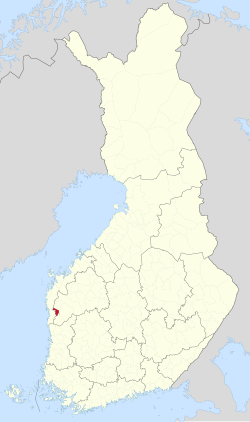You can help expand this article with text translated from the corresponding article in Finnish. (June 2023) Click [show] for important translation instructions.
|
Karijoki
Bötom | |
|---|---|
Municipality | |
| Karijoen kunta Bötoms kommun | |
 Karijoki in 1990 | |
 Location of Karijoki in Finland | |
| Coordinates: 62°18.5′N 021°42.5′E / 62.3083°N 21.7083°E | |
| Country | |
| Region | South Ostrobothnia |
| Sub-region | Suupohja sub-region |
| Government | |
| • Municipal manager | Marko Keski-Sikkilä |
| Area (2018-01-01)[1] | |
| • Total | 186.54 km2 (72.02 sq mi) |
| • Land | 185.58 km2 (71.65 sq mi) |
| • Water | 0.78 km2 (0.30 sq mi) |
| • Rank | 267th largest in Finland |
| Population (2024-08-31)[2] | |
| • Total | 1,169 |
| • Rank | 287th largest in Finland |
| • Density | 6.3/km2 (16/sq mi) |
| Population by native language | |
| • Finnish | 96% (official) |
| • Swedish | 1.7% |
| • Others | 2.3% |
| Population by age | |
| • 0 to 14 | 11.4% |
| • 15 to 64 | 52.4% |
| • 65 or older | 36.3% |
| Time zone | UTC+02:00 (EET) |
| • Summer (DST) | UTC+03:00 (EEST) |
| Website | www.karijoki.fi |
Karijoki (Finnish: [ˈkɑriˌjoki]; Swedish: Bötom) is a municipality of Finland. It is part of the South Ostrobothnia region. The population of Karijoki is 1,169 (August 31, 2024),[2] which makes it the smallest municipality in South Ostrobothnia in terms of population. The municipality covers an area of 185.58 km2 (71.65 sq mi) of which 0.78 km2 (0.30 sq mi) is inland water (January 1, 2018).[1] The population density is 6.3/km2 (16/sq mi). The municipality is unilingually Finnish.
A neanderthal cave, the Wolf cave, was found in the Pyhävuori mountains in Karijoki in 1997.
- ^ a b "Area of Finnish Municipalities 1.1.2018" (PDF). National Land Survey of Finland. Retrieved 30 January 2018.
- ^ a b c "Finland's preliminary population figure was 5,625,011 at the end of August 2024". Population structure. Statistics Finland. 24 September 2024. ISSN 1797-5395. Retrieved 25 September 2024.
- ^ "Population according to age (1-year) and sex by area and the regional division of each statistical reference year, 2003–2020". StatFin. Statistics Finland. Retrieved 2 May 2021.
- ^ a b "Luettelo kuntien ja seurakuntien tuloveroprosenteista vuonna 2023". Tax Administration of Finland. 14 November 2022. Retrieved 7 May 2023.
